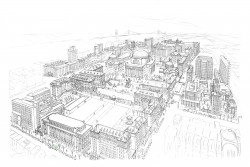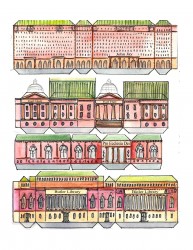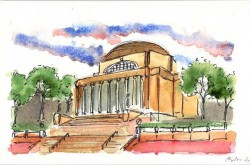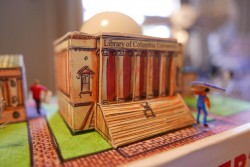Nobody puts baby in a corner, sure, but what about putting a campus in a box? Myles Zhang, CC ’19, has done just that with one of his latest projects, which features a miniature Columbia inside a vintage cigar box. Myles has a blog and a YouTube page where he displays his photography, ink drawings, watercolors, and even sculptures. Now that his first year at Columbia is coming to an end, Daily Editor Lila Etter sat down with Myles to discuss his work, his inspirations, and what makes Columbia, Columbia.
Bwog: So, Myles, tell us a little more about this project.
MZ: The project was to create a small model of Columbia out of the small, little cigar box I found around the house. I had some time during summer break, so I decided to kind of conceptualize this idea and try to imagine how much of Columbia’s campus I could physically fold into the box, given the model. So I thought about it for two or three nights, trying to conceptualize where the structures should be located, where the courtyards should be located, such that the top of the box would fold down to the bottom half, and all the structures would fit snuggly together. All in all it wasn’t too difficult a project, because most of the conceptualizing was done beforehand, and the actual execution only took four or five days.
Bwog: What’s equally incredible are your ink drawings, sketches, and watercolors of campus. Which came first?
MZ: Actually, well, some of the sketches and watercolors came beforehand, then came the miniature model immediately before school started. And then over winter break I did that large watercolor of Columbia, the one with all those details.
Bwog: Do you think that those sketches and watercolors inspired the 3D model?
MZ: I’ve always liked the idea of 3d creations, the idea of entire small worlds folding out of a box. The idea of a journey of experiencing the model, when one has a small box and opens it up and finds something unexpected inside. Whereas with a drawing, one is just presented with the image and doesn’t have to zoom in to understand the image in greater detail. The box gives a journey of experiencing the art. That’s what I enjoy.
Bwog: You also seem to enjoy using film to display your work, and sometimes that medium takes on a life of its own. (The “Columbia Fight Song” video, for example.) How does film coincide with the mediums of drawing, watercolor, and architectural models?
MZ: I think film is good at adding a narrative to the drawings. It allows me to disseminate something to a larger audience, which I think is the most important thing. Secondarily, it allows me to tell a story that wouldn’t be visible by just looking at the drawing. I can incorporate a series of several images and add cropping, or photoshop, or sound effects to tell a story about how I see the image in a larger context. Just like how my experience of living in Newark is reflected in the films that I’ve made or in my drawings.
Bwog: Speaking of Newark, one page on your site describes growing up in Newark, New Jersey. You wrote, “In retrospect, my transient city inspired my quest for permanence and stability.” Have you found that sense of permanence in Manhattan? How has living in New York changed your idea of a city?
MZ: Living in New York wasn’t the most difficult transition because I was coming from Newark, so it was just one urban environment to the next. But I think that coming to Columbia specifically, I was really surprised. It’s a smaller box – literally – than I had imagined. Sometimes I have to remind myself that although I’m at Columbia, I’m still in New York, and I’m still part of this larger collective. I’m not in this box. Maybe the idea of “Columbia in a box” can work in the sense of a small model, but also in the sense of a bubble. One of the criticisms of Columbia is that it is a bubble, it is a literal box that someone has to open up when coming here. Implicit to my “Columbia Fight Song” is that criticism of Columbia, which is something I only realized in retrospect.
Bwog: You created this model of Columbia before your first day of college. How has your view of the campus – and perhaps also of the institution itself – changed since then?
MZ: That’s a very good question. Like most students coming here, there’s an initial excitement: all these wonderful classes, great food in the dining halls, and there’s this desire not to return home because it seems that this campus has everything. The more time I spend here, the more I realize that, yes, I love Columbia, I really found a home here. But like all homes, it’s not perfect, and there are certain things that this campus can’t offer. That’s not so much losing my naiveté, but just understanding Columbia in greater depth.
Bwog: In the process of creating the model, was there any aspect of Columbia’s architecture that stood out to you as unique?
MZ: This campus is unique in that it’s a very urban campus. Unlike Yale or Cornell, Columbia is really centered on this six-block unit. That really shapes the campus into a geometric grid in which everything aligns in a grid of structures. And this provides a wonderful opportunity for this urban vista when one goes down college walk, with the buildings channeling you on either side. A recreation of the urban street, then suddenly this large courtyard opens out, and you’re in the middle of a large urban park, a public space. I realized that, in coming to Columbia, there is a certain beauty to the campus in its undiscovered surprises.
Bwog: Within the model of campus, you’ve specifically chosen to display figures representing activism – for example, someone carrying a mattress, whom you’ve captioned “Emma Sulkowicz?”. What was your thought process behind including these particular figures?
MZ: Well, the figure is definitively Emma Sulkowicz, but I had run out of female figurines. One can twist that in a different direction, I suppose, beyond my lack of supplies [laughs]. There was also a No Red Tape Protester, also male, for lack of figurines. There are maybe some implications of that which are completely unintentional. But the people of Columbia are very integral to its campus culture. Students come because they like the campus and the courses, but I think the ultimate reason for being here is that there’s such a dense concentration of talented and interesting people. I feel like in high school I had to look for people who were truly interesting or dedicated to their passions, whereas here I can talk to pretty much anyone in the dining hall and leave with a pretty inspiring conversation, after seeing their point of view.
Bwog: Zooming out, where and when did your passion to create art – be it sketches, watercolors, or models – originate?
MZ: In that “transient urban environment,” I suppose. People often ask me, “Why do you draw?” It happened so long ago – more than ten or so years ago – that I can’t really remember what inspired it. It’s enjoyable, and part of my motivation for continuing is that it lends a sense of self-completion. With classes, one can define oneself, but not independently of standards or rubrics. When I’m drawing I have complete liberty. I’m the one who creates my own projects, my own rules and guidelines. When I can draw and paint whatever I want, I have a sense of autonomy that I don’t get from academics.
Bwog: Which artist(s) would you consider to be your greatest inspiration(s)?
MZ: I like Edward Hopper. Maybe Nighthawks or his urban scenes. There’s a certain melancholy to it, and I really like his use of paint and shadow. His work is very grounded in the 1930s, so looking at his images is like looking back into another time period. He captures the feeling of the Great Depression in a kind of visual intensity.
Bwog: You’ve said that you plan on majoring in Urban Studies and Art History at Columbia. Is the dream job being an architect?
MZ: I’ve always said that I’m “majoring in the liberal arts” [laughs]. Right now it’s Art History and maybe the Theory of Architecture. I think the end goal is becoming an architect, I’ve wanted to be one for as long as I can remember. I’m not sure what inspired it. Of course, I can give myself the story that it was all the destruction around me as a child. But ultimately, there’s just something that draws me to buildings. It’s really about the process of becoming an architect and learning and growing and exploring new interests. Ten or so years from now, I’ll maybe have the license, but it’s the process of getting there that I’m looking forward to.
Bwog: What’s next for you?
MZ: I want to do more drawings of the city, like that one of Columbia, and I’ve been working on more watercolors of lower Manhattan. I want to do different NYC neighborhoods and catch little details in each one. The little nefarious details. For example, my drawing of lower Manhattan was Occupy Wall Street protesters and police violence. I just try to incorporate the details that aren’t so visible upon first notice. It does lend a certain pleasure to it to know that when I draw this image, people will look closely to see the humor. [Laughs] Perhaps the dark humor.
Bwog: We have to ask… Who else has there been besides Bwog? Do you share your work, or is it a more personal thing to you?
MZ: Definitely not a personal thing, which is partially why I have the blog. I want to disseminate it to as many people as possible, and I’m very comfortable with sharing the work. I think it can languish in a closet, but that doesn’t do anyone any good. When I put 100 hours into a drawing, I want people to see it. So yeah, I definitely want the work to have an audience.
This interview has been edited for clarity.
- Ever look at something and think, “Wow, I wish I could draw”?
- Paper cutouts for the model
- And then this…
- …becomes this.
All images belong to the artist and can be found here.


 0 Comments
0 Comments




